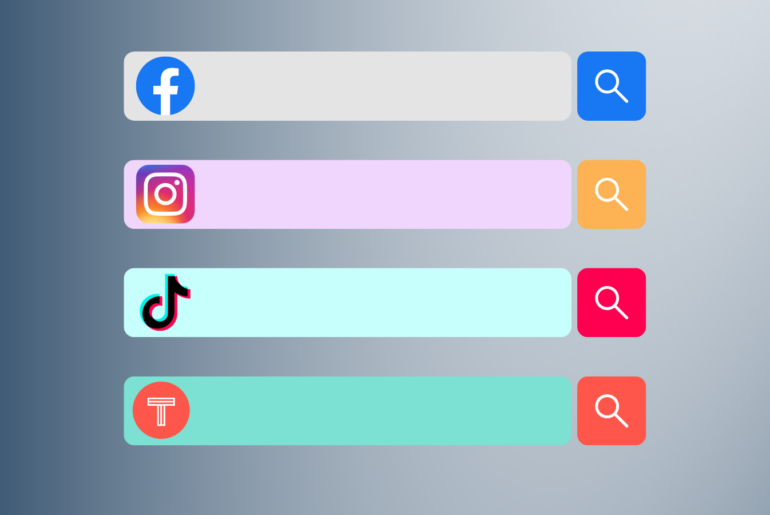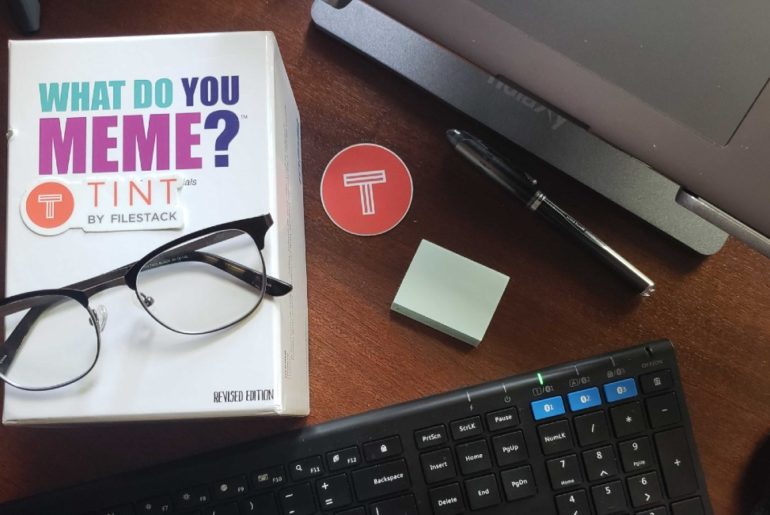Our mission at TINT is to provide marketing teams with the absolute best in social media and marketing technology. But our mission doesn’t stop there — we are committed to advancing marketing and social media through technology however we can. So we launched Social Studies earlier this year and the response has been great. Thank you to our tens of thousands of dedicated readers.
Today I am happy to announce our newest creation — the Social Studies Podcast. I have invited industry leading pros in social media, marketing, and technology to share their stories and lessons learned with all of us. The podcast is short format but packed with knowledge — perfect for your commute or lunch break.
To celebrate our launch, we are going to release one episode per day this week. Our inaugural episode features Austin Gunter, Senior Marketing Manager at vendhq.com.
Hope you enjoy listening as much as we do making the podcast. Please tweet us with comments and requests @TINT with #SocialStudies.
Social Media is a Trailing Indicator of Customer Experience
Nathan Zaru: Hey, everyone. Welcome back to the latest episode of the Social Studies podcast. Today, I’ve brought Austin Gunter in, a good marketing friend of mine in San Francisco, to talk about how social media is a trailing indicator of customer experience. He’s a writer for many years and long time marketer. I really hope you enjoyed this episode as much as I liked it. Hey, Austin, man. Welcome to the show today.
Austin Gunter: Hey, Nathan. Thanks for having me.
Nathan:> Absolutely, man. I’m really stoked to have you on Social Studies with me. We’ve been talking about marketing for years. This is the first time we’ve actually made it official.
Austin: Yeah. When you started the podcast, I was stoked to be on it. The audience that you’re building is pretty exciting, man.
Nathan: It’s really great having such a big audience. We service companies all over the world. We have thousands of customers all over the world. Being in San Francisco is such a unique opportunity, for marketing and technology, and everything. Right?
Austin: Yeah. I’m always blown away by the ways that you could sit down and just go grab drinks with friends, and the people that meet, you always learn something from them. Everybody’s always pushing the limits of their abilities. It keeps me honest, so that I’m aware of my own limitations. It’s an inspiring place to be, with a lot of really talented people.
Nathan: I couldn’t agree more to that. Let’s just jump into it. I feel like there’s so much to cover. You’re a writer, you’re a marketer, you’re Vend. Can you give us a quick overview as to what you are, and before we jump into some hardcore marketing advice?
Austin: Yeah, man. I’m one of those sell out writers. I remember when I was in college, I had this professor who was like 33 years old, and he was a comedian, and did a bunch of stuff. It was an adjunct professor at my university who came in and talked about how he lived in a van in his 20s, but had finally made it and was making $40,000 a year writing comedy, and had a wife and a daughter.
He was imploring us not to sell our talent for money, and I remember writing notes. I wrote one note for that talk, and I said, the starving artist may be an artist, but he’s still fucking starving. I never wanted to starve, so when I graduated in 2009 with a degree in writing and rhetoric, I sort of stumbled into the tech industry, writing. I wrote a job description to create my first job at an incubator in Austin, Texas, and then I wrote another job description to join WP Engine as employee number 12, I think, back in the day.
Nathan: WP Engine helps companies host their WordPress blog, right?
Austin: WP Engine is the host if you’ve got a WordPress blog.
Nathan: Right.
Austin: I moved out to San Francisco with them, about two years ago, in 2013. Actually, 2012. I joined Vend early last year to help open the Vend San Francisco office, because Vend is a New Zealand based company, and we are, basically, doing the go to market in all of North America for Vend’s retail point of sale solution.
Nathan: Okay, so humor me. Point of sale could mean a lot of things for a lot of different companies. What does point of sale look like for Vend, nowadays?
Austin: What we do is, we don’t do the payments, we do the operations, inventory management, customer management, loyalty, for small to medium retailers globally. It’s a cool challenge as a marketer, because small business customers … I actually heard a quote today that small business customers are harder to reach than teenagers.
From a marketing perspective, it’s a really unique challenge, because we’re trying to provide an affordable solution for these entrepreneurs, essentially, and then also do it in a way that’s cost effective from a sales and marketing perspective.
Nathan: How does a writer fork himself in the middle of a point of sale technology solution?
Austin: I think by the time I got out to Silicon Valley, I’d already forked myself into tech. I’ve always been a creative person, but I’ve always believed that adaptability and introspection, like self awareness, were some of the biggest keys to getting what you wanted out of life. I’ve always been willing to throw myself at a new situation, in order to grow and make sure that I could adapt to changing circumstances, and get from point A to point B, whatever that happened to be at the time.
Nathan: I’ll link to it in the show notes, but you have a blog that, actually, coincidentally, I remember reading about the Yerba Mate article before I even knew you. The blog is big. The blog is very successful, and you have a good Twitter following, as well. You’re going to talk to us about social media today.
Austin: Yep.
Nathan: In particular, I think you told me you wanted to mention social media is a trailing indicator of something or other.
Austin: Yeah. I got into social media really early on, because it was a way for me to have conversations at scale. There’s actually a really good book that I recommend you guys read, called The Social Side Door, or The Social Media Side Door. It’s by the guy who used to be the head of content at a publicly traded company called Bazaarvoice.
He put a story of mine in there about how I got an interview at Google, because I met a Google recruiter on Google, and reached out to him, and then just because I’d introduced myself on Twitter, he put my name into their recruiting platform, and then I got an interview and actually a job offer out of that, which I turned down, strangely enough.
Nathan: You turned down a job. We don’t have to get into that, but that’s interesting.
Austin: The point is that you can create opportunities with social media.
Nathan: Right.
Austin: Actually, two long term girlfriends I’ve met from Twitter or my blog.
Nathan: Two long term girlfriends you’ve had personally, from Twitter and your blog.
Austin: Personal. Yes.
Nathan: If you want to step your romantic game, Twitter and your blog is the way to go?
Austin: I think that means I spend too much time online.
Nathan: All right.
Austin: I wouldn’t recommend that for anybody else. I think Tinder’s working out pretty well for everybody else. My point is that, social media was something that I really love because the way that I was able to have conversations with amazing people, that I wouldn’t otherwise have access to.
When I joined WP Engine, one of the things that I started doing was, social media, and that turned into social media support, because for those of you that know, that have businesses that are high support, like a hosting company’s a good example of that, high support volume, also highly technical customer, it’s very likely that social media is going to be a massive channel for your support, or it’s going to be a massive support channel for your company.
I don’t think that’s new information, but it is interesting. What we started to realize, was that when things were going really, really well, customers were telling us on Twitter. They would actually sell the product for us. If somebody was asking us a question on Twitter, they would say, “Hey, guys. Your prices are kind of high. Is it worth it?” I realize if I was going to answer that question via the brand Twitter handle, I had zero credibility.
I thought, you know what, if I retweet this, I know that I have a lot of advocates on social media, if I retweet this and say, “Hey guys. You guys are actual customers. Could you answer this based on your experience?” What would happen is, our customers would actually make the sale for us on Twitter. It was amazing to watch. I actually have a couple of Storify links that you could check out, where, for an hour, you’ve got our real customers selling a potential customer on the feature set, and then you could trace that back to an actual sign up and trace that up to revenue.
Furthermore, that’s even better, because one of the things that consumers are doing now, is, when somebody goes to learn about a company, they can pull all the information towards you. This number’s been changing, but, social media and content marketing is taking up 60, 70% of your sales funnel. This is actually part of the blog post that I wrote about, is that, social media is an indicator of your customer experience, and it’s also your sales force.
Everything that happens on your social channel is, basically, the reputation that your company has. It’s what people are going to know about your company. You can’t control the message anymore. You actually have to have a great product, and then let your customers tell that story on your behalf, so social media was the way to amplify that. Not only would we see one person get sold on social media, but everybody that was looking for information about our product versus any of our competitors, and there were several, they might see our social channel with tons of testimonials and lots of really, really positive things to say, versus some of the other competitors, which were all support issues.
Nathan: This sounds great.
Austin: I’m just getting started.
Nathan: I’ll take one of those, right? I feel like I’d be remiss to ask you to explain a little further. You said that your customers sold the product for you?
Austin: Totally. Totally. Word of mouth.
Nathan: Word of mouth. Word of mouth is Twitter now. Is that what it is?
Austin: Word of mouth has always existed.
Nathan: Of course. Twitter and social media, just like they’ve dealt with everything else, have given people scale, but also focus because they can find where the conversation’s happening. Right?
Austin: Right.
Nathan: Interesting.
Austin: You have to think about your social channel as not something that needs to be locked don from a corporate perspective, but an actual opportunity for people to get to know your company and your ethos. Companies that hire amazing employees, that are doing good work and lead interesting lives, do themselves a service when those customers are on social media, because those customers then become a reflection of that company’s values and that company’s brand, just like a support experience.
This, in particular, this example of hosting customers, potential hosting customers looking for answers, on Twitter, it’s amplified, because these are very active Twitter users, because they’re very active in the open source software community, because it’s WordPress. They’re already having conversations there, in the first place.
Then, they’re going to ask each other on social media, because they don’t always live in the same area of town. They live in different cities. They’re going to ask each other on social media, “Is this a good company, or not?” You could have those conversations out there, in the public eye period. Then, the question is, you’ve got a positive example, but what happens when things go bad?
Nathan: No, really bad.
Austin: It’s a tech company. You’re building things. Sometimes there’s down times. Sometimes there’s an issue, et cetera. Now, people will take to Twitter, however, I will tell you, that there can be a fearsome times of, “Oh, social media is bad. We don’t want people to be saying bad things about us.” There are very few people who will go immediately to Twitter to complain about your product or your service.
There is a subset of people that are negative, and have nothing positive to say, and that they will come after you for the slightest turbulence in your service, but then if you go and look at the rest of what they’re saying on Twitter, they’re complaining. They’re not bringing anything to the table.
They have a Twitter account, or a Facebook account, literally just to complain when they feel that the world has done them wrong.
Nathan: For these people, how do you determine who they are, and do you just ignore them?
Austin: You never ignore anybody on social media. You always want to engage people directly, and be polite and be kind, because again, like I said, that conversation’s going to be out there in public. One of the things that we noticed, was that, as a tech company, what will happen is, you may have some issues with your submission with your product.
It’ll take people time, it’ll take people a certain amount of time to go out onto social media to engage that. That depends on the company. For a highly technical customer base, they will go out to social media, but they’ll do it after they’ve been on Zen Desk for your support team to work with. They’ll do it after they’ve made a phone call. They’re only going to go out on social media when they feel like they’ve, literally, exhausted all of their options and they want to figure out what’s going on, and they want to have a public way to hold you accountable.
To think about that from a perspective of how is that an opportunity? If a customer’s saying, “Hey, I want to publicly hold you accountable to this,” what they’re saying is, “I’m holding you to a high standard, and I want you to live up to it.” Social media becomes that place where you can actually engage them.
We started running reports and we realized that there was a certain delta of time, where if there was blip in social media, it had been preceded in a blip of ticket volume.
Nathan: Ticket volume? Really?
Austin: Our social media, we can trace that very directly to what was going on in support channels. It was a way for us to look at how support was reforming. It was a way for us to track issues that might be going on, so we could actually trace that back to the product. Trace that back to the customer experience. Trace that back to sales.
I actually have a report that I hand out to people sometimes, I use a tool called conversocial, to measure the sentiment of all of my Tweet’s every week.
Nathan: social media analysis kind of thing.
Austin: Conversocial is fairly rudimentary when I was doing this, because it’s been a little while at this point. We would actually go through and manually measure sentiment every week and then assign it. There’s ways to do this with actual machine learning now. The important thing is to setup a positive, neutral, negative sentiment for all your Tweets, so you know, this is an advocate, or a detractor, or this is somebody who’s just neutral. Maybe they’re retweeting us, or whatever.
Then, you set up a series of classes of tweets. You’ve got testimonials. You’ve got support issues. You’ve got product down. You’ve got things like that. You’re report for your company will be different than my report from my company would be, because the product.
By keeping track of that sentiment and that type of engagement on social media on a weekly basis, you’re able to actually learn a ton about what’s going on with your business, almost in real time. It’s a way of having a live analytics platform running for the way people feel about your brand and feel about your product.
It became such a powerful tool. It’s something that exec teams love to see, because how else are they going to get that sort of insight into what’s going on in their customer’s minds on a minute by minute basis.
Nathan: Are you showing distributions, X % are positive, neutral or negative. Is that how it works?
Austin: I would do an executive summary of it where I would say, this was how the positive tweets broke down this week. There were this many testimonials, this many engagements, this many customer referrals, and then the negative tweets.
This many product down. This many, I haven’t heard from your support team in two days. This many, why aren’t you answering your phones? That gets sent back to the support team as a feedback mechanism for them. I have a full report for this. For execs, they just want to see the exec summary, or they want to be able to make a decision based on that, but the numbers were all there. It just had a pivot table where I was putting all this stuff together every week.
Nathan: How does the social media team and the customer support team work together, if at all?
Austin: It depends on the company. I think more and more, they’re aligned. Customer success can encompass the social media team. At a high level, I think marketing and customer success have an increasingly blended role, and you’ll see a lot of marketers who started out as community managers, as a part of the marketing teams, and have found their jobs turning into more support based roles a lot of the time, just because that’s a natural iteration of where those conversations go.
You go from marketer and then you realize that there was a heavy support component, to just being available to have conversations with customers online, and then it turns into an incredibly important front facing support role, where you’re actually representing your entire company with every 140 characters that you tweet.
Nathan: Sure. You do your best to support your customers. You do your best to market to your customers, but they’re going to social media, regardless. How do you keep your eye on the ball?
Austin: How do you keep your eye on the ball?
Nathan: Yeah.
Austin: You’ve got to have somebody who’s paying attention to it all of the time.
Nathan: All right.
Austin: When I lived in front of Tweet Deck, because that was the best live update to pay attention to what was going on. I actually had, for years, I had every single social media interaction that a very quickly growing company had pushing a phone. Actually, it burned me out on social media a little bit, and I deleted all social media apps off my phone, so they didn’t distraction any more. There’s no other way to do it, other than being available to, because social media, the expectations for response are so immediate, that if it takes you more than half an hour to get back to somebody, then you’re failing at the worst possible, most public place that you could fail your customers, from a customer success standpoint.
Nathan: Right. Keep your eye on social media, respond quickly, make their experience positive.
Austin: Track what’s happening every week. Map the trends and that gets you a sense of how to adjust your product. It gives you a sense of what’s working, what’s not. It’s a positive indicator, too. It tells you exactly what’s working, as well as what’s not. I don’t know of a better way to really feel the heartbeat, and know the health of your company, than paying attention on social media.
Nathan: Awesome. Keep the experiences positive. Watch your customers and respond to them quickly. Thanks so much, Austin. We appreciate it.
Austin: Thanks, Nathan.
Nathan: Cheers.
###
Photo credit Galen Oakes Photo




